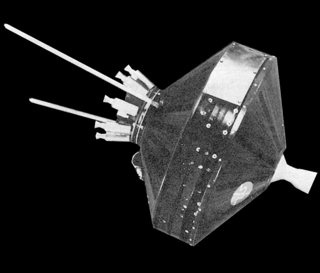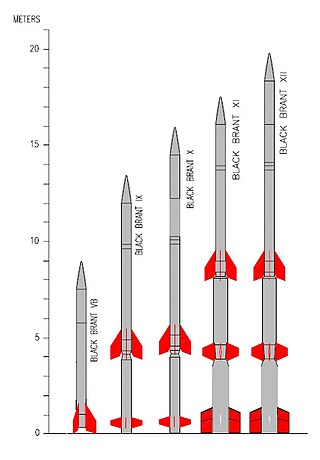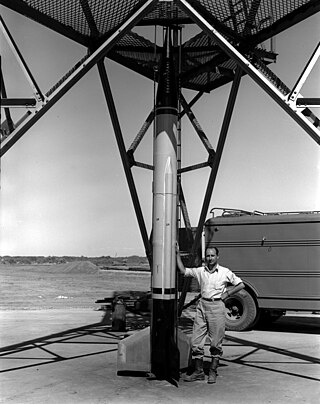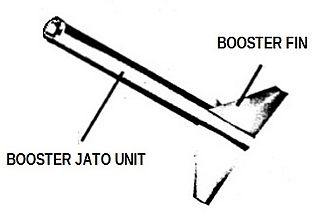
A rocket is a vehicle that uses jet propulsion to accelerate without using the surrounding air. A rocket engine produces thrust by reaction to exhaust expelled at high speed. Rocket engines work entirely from propellant carried within the vehicle; therefore a rocket can fly in the vacuum of space. Rockets work more efficiently in a vacuum and incur a loss of thrust due to the opposing pressure of the atmosphere.

Energia was a 1980s super-heavy lift launch vehicle. It was designed by NPO Energia of the Soviet Union as part of the Buran program for a variety of payloads including the Buran spacecraft. Control system main developer enterprise was the Khartron NPO "Electropribor". The Energia used four strap-on boosters each powered by a four-chamber RD-170 engine burning kerosene/LOX, and a central core stage with four single-chamber RD-0120 (11D122) engines fueled by liquid hydrogen/LOX.

A solid-propellant rocket or solid rocket is a rocket with a rocket engine that uses solid propellants (fuel/oxidizer). The earliest rockets were solid-fuel rockets powered by gunpowder; The inception of gunpowder rockets in warfare can be credited to ancient Chinese ingenuity, and in the 13th century, the Mongols played a pivotal role in facilitating their westward adoption.

Pioneer 0 was a failed United States space probe that was designed to go into orbit around the Moon, carrying a television camera, a micrometeorite detector and a magnetometer. It was part of the first International Geophysical Year (IGY) science payload. It was designed and operated by the Air Force Ballistic Missile Division as the first spacecraft in the Pioneer program and was the first attempted launch beyond Earth orbit by any country, but the rocket failed shortly after launch. The probe was intended to be called Pioneer, but the launch failure precluded that name.

The Aerobee rocket was one of the United States' most produced and productive sounding rockets. Developed by the Aerojet Corporation, the Aerobee was designed to combine the altitude and launching capability of the V-2 with the cost effectiveness and mass production of the WAC Corporal. More than 1000 Aerobees were launched between 1947 and 1985, returning vast amounts of astronomical, physical, aeronomical, and biomedical data.

The Delta rocket family was a versatile range of American rocket-powered expendable launch systems that provided space launch capability in the United States from 1960 to 2024. Japan also launched license-built derivatives from 1975 to 1992. More than 300 Delta rockets were launched with a 95% success rate. The series was phased out in favor of the Vulcan Centaur, with the Delta IV Heavy rocket's last launch occurring on April 9, 2024.

The Black Brant is a family of Canadian-designed sounding rockets originally built by Bristol Aerospace, since absorbed by Magellan Aerospace in Winnipeg, Manitoba. Over 800 Black Brants of various versions have been launched since they were first produced in 1961, and the type remains one of the most popular sounding rockets. They have been repeatedly used by the Canadian Space Agency and NASA.

The Scout family of rockets were American launch vehicles designed to place small satellites into orbit around the Earth. The Scout multistage rocket was the first orbital launch vehicle to be entirely composed of solid fuel stages. It was also the only vehicle of that type until the successful launch of the Japanese Lambda 4S in 1970.

Loki, officially designated 76mm HEAA Rocket T220, was an American unguided anti-aircraft rocket based on the German Taifun. Like the Taifun, Loki never saw service in its original role, but later found widespread use as a sounding rocket. It was so successful in this role that several advanced versions were developed on the basic Loki layout, including the final Super Loki.

The WAC Corporal was the first sounding rocket developed in the United States and the first vehicle to achieve hypersonic speeds. It was an offshoot of the Corporal program, that was started by a partnership between the United States Army Ordnance Corps and the California Institute of Technology in June 1944 with the ultimate goal of developing a military ballistic missile.
Taepodong-1 was a three-stage technology demonstrator developed by North Korea, a development step toward an intermediate-range ballistic missile. The missile was derived originally from the Scud rocket and was tested once in 1998 as a space launch vehicle. As a space launch vehicle, it was sometimes called the Paektusan 1.
The Nike-Cajun was a two-stage sounding rocket built by combining a Nike base stage with a Cajun upper stage. The Nike-Cajun was known as a CAN for Cajun And Nike. The Cajun was developed from the Deacon rocket. It retained the external size, shape and configuration of the Deacon but had 36 percent greater impulse than the Deacon due to improved propellant. It was launched 714 times between 1956 and 1976 and was the most frequently used sounding rocket of the western world. The Nike Cajun had a launch weight of 698 kg (1538 lb), a payload of 23 kg (51 lb), a launch thrust of 246 kN (55,300 lbf) and a maximum altitude of 120 km (394,000 ft). It had a diameter of 42 cm and a length of 7.70 m. The maximum speed of the Nike-Cajun was 6,760 km/h (4,200 mph).
Thiokol (variously Thiokol Chemical Corporation, Morton Thiokol Inc., Cordant Technologies Inc., Thiokol Propulsion, AICGroup, then part of Alliant TechsystemsInc., then ATK Thiokol, ATK Launch Systems Group; finally Orbital ATK before becoming part of Northrop Grumman Innovation Systems and Northrop Grumman was an American corporation concerned initially with rubber and related chemicals, and later with rocket and missile propulsion systems. Its name is a portmanteau of the Greek words for sulfur and glue, an allusion to the company's initial product, Thiokol polymer.

Arcas was the designation of an American sounding rocket, developed by the Atlantic Research Corp., Alexandria, Va.

Satish Dhawan Space Centre – SDSC, is the primary spaceport of the Indian Space Research Organisation (ISRO), located in Sriharikota, Andhra Pradesh.

Atlas is a family of US missiles and space launch vehicles that originated with the SM-65 Atlas. The Atlas intercontinental ballistic missile (ICBM) program was initiated in the late 1950s under the Convair Division of General Dynamics. Atlas was a liquid propellant rocket burning RP-1 kerosene fuel with liquid oxygen in three engines configured in an unusual "stage-and-a-half" or "parallel staging" design: two outboard booster engines were jettisoned along with supporting structures during ascent, while the center sustainer engine, propellant tanks and other structural elements remained connected through propellant depletion and engine shutdown.

Capricornio was a Spanish satellite launch vehicle developed by the Instituto Nacional de Técnica Aeroespacial (INTA) in the 1990s. It was intended to be Spain's first launcher.

The Nike stage or Nike booster, a solid fuel rocket motor, was created by Hercules Aerospace for the Nike Ajax (M5) Nike Hercules (M5E1). It was developed for use as the first stage of the Nike Ajax and Nike Hercules missiles as part of Project Nike.
OneSpace or One Space Technology Group is a Chinese private space launch group based in Beijing, subsidiaries in Chongqing, Shenzhen and Xi'an. OneSpace was founded in 2015. OneSpace is led by CEO Shu Chang, and is targeting the small launcher market for microsatellites and nanosatellites. OneSpace launched China's first private rocket in 2018.















